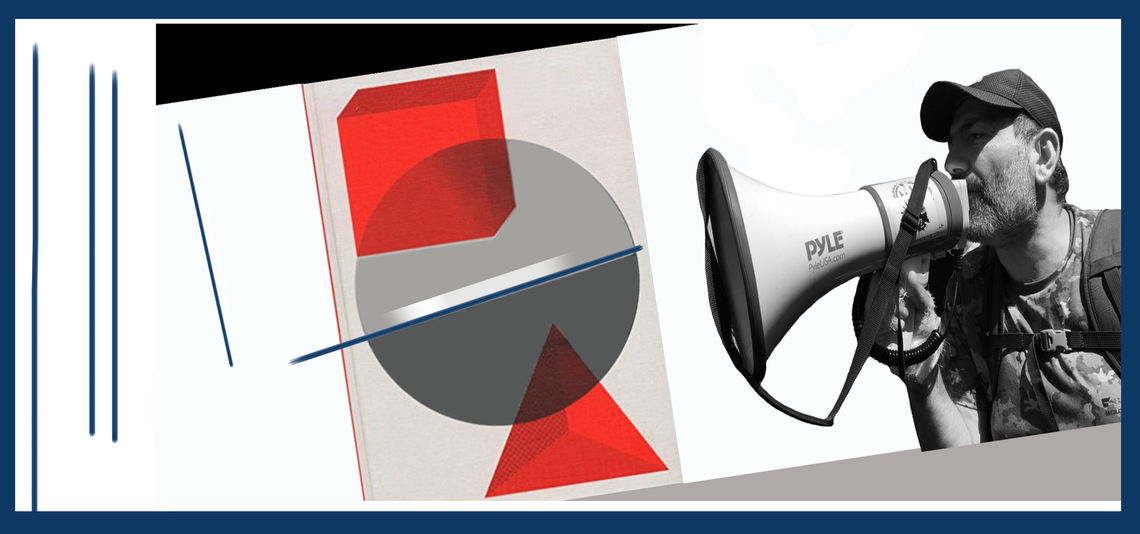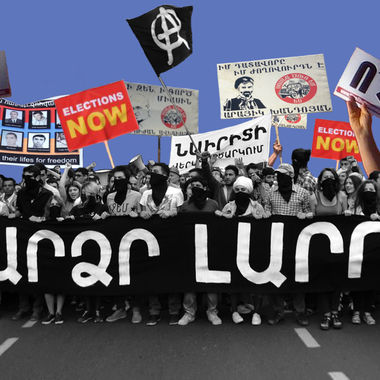Wed Jun 20 2018 · 9 min read
Aggressive Centrism: Navigating the Contours of Nikol Pashinyan’s Political Ideology

By Nerses Kopalyan

In non-democratic regimes, the discourse on political ideology is generally a moot point, for autocrats are less concerned with ideational goals and objectives than they are with keeping and expanding their powers. Inherently, in autocratic regimes, there lies the presence of artificial ideology. In this context, it would not make much sense to assess the political ideology of Armenia’s past leaders or governments. The conservative-liberal continuum, or the right-wing versus left-wing polarity, remain incoherent: who cares where Levon Ter-Petrossian, Robert Kocharyan, or Serzh Sargsyan stood on any political ideology scale; their policies were not shaped by ideology, but rather, by a drive to consolidate illegitimate power through patronalistic politics.
This artificial ideology became most acute with the Republican Party of Armenia (RPA), who utilized the ultra-nationalism of historic hero Garegin Nzhdeh to formulate a center-right party that extolled security and patriotism over all other social issues. Comically, this patriotism and security fell victim to a culture of corruption, abuse of power, and pure ideological incoherence. To this end, post-Soviet Armenia has been deprived of politics that offers ideological precepts: citizens, pundits, and politicians simply do not engage in ideological debates, they only engage in policy debates. This deficiency in Armenia’s non-democratic political culture reinforced the absence of substantive political ideology.
Enter Nikol Pashinyan upon being swept into power through the so-called Velvet Revolution, and the inquiry of pundits and political commentators on this same topic: What is the political ideology of this new government? For the average Armenian citizen, this is an awkward question, because, once again, the citizen is more concerned with practical, legal, and policy implications than they are with the ideological leanings or the underlying intellectual precepts of their new leader. The citizen’s relative indifference is understandable, but, at the same time, it should not be acceptable, for ideological indifference presupposes a lack of healthy development in a society’s political culture. More simply, as Armenia proceeds to develop and democratize, so must its political culture, and so must the intellectual and political acumen of its citizen. In this sense, we have finally reached a point in Armenia’s political history where not only will political ideology matter, but also, we must undertake the task of qualifying and defining what these political ideologies are.
On May 1, 2018, when Nikol Pashinyan was being questioned during the Parliamentary session that led to the initial failed vote on his nomination to the prime ministership, several MPs of the Republican Party targeted their questions on the issue of political ideology. Did Pashinyan subscribe to conservatism or liberalism? Further, what defined either his conservative or liberal ideological beliefs? Pashinyan’s answers to such questions profoundly frustrated the Republicans, who, led by Deputy Speaker of Parliament Eduard Sharmazanov, accused Pashinyan of providing non-answers. However, above and beyond the intellectual limitations of Sharmazanov, Pashinyan did provide a cogent and nuanced answer, one that flew over the proverbial heads of the Republicans, but one that offered a transparent window into his political ideology.
Utilizing the epistemic tools of post-modernism, Pashinyan collapsed the conservatism-liberalism dichotomy: he did not subscribe to the ideological rigidity of any of the “-isms,” but rather embraced the very deconstruction of this dichotomy.
Pashinyan stipulated that he did not fall into the conservatism-liberalism continuum, that the discourse on the various “-isms” that defined traditional political ideology is no longer applicable to the politics of the contemporary, globalizing world. Utilizing the epistemic tools of post-modernism, Pashinyan collapsed the conservatism-liberalism dichotomy: he did not subscribe to the ideological rigidity of any of the “-isms,” but rather embraced the very deconstruction of this dichotomy. Noting the lack of tenability in ideological rigidity, Pashinyan constructed the paradigmatic lens of his ideology through fluidity. More simply, whatever ideological “-ism” he may subscribe to, this subscription would not be rigid and inflexible, but rather, it will be fluid and accommodating. Well, so far so good, but again, how can we qualify and understand what exactly defines Pashinyan’s political ideology? To do so, we turn to French politics, that is, the extent to which Pashinyan is borrowing from the political ideology of France’s young President Emmanuel Macron.
Very much like Pashinyan, Macron is a young leader who was unexpectedly swept into power within a very short amount of time, thus facing the Herculean task of staving off the old, entrenched political interests, while at the same time meeting the very high expectations of a vibrant, dynamic society. Clearly French society is extremely different than Armenian society, whether in development, economic might, geopolitical issues, or in global stature; but the comparison here is not between the two countries or political systems, but rather, in the approaches by the two leaders. To a substantive level, Pashinyan has been emulating Macron, and doing so quite successfully. This successful emulation, then, has allowed us to cogently qualify what Pashinyan’s political ideology is, and more specifically, what it entails. Macron’s general ideational goals have posited emphasis on three main areas: reforming existing institutions, undertaking active and intense multilateralism, and extolling the soft power of French culture. These perimeters that shape his political ideology, Macron has labelled as “radical centrism.” As we will see, to a very large extent, the Pashinyan government has, in broad terms, emulated these grand strategies. In this context, if we are seeking to figure out what the political ideology of the Pashinyan government is, it quite simply falls within the confines of radical centrism.
Radical centrism, however, may come off as contradictory to many observers, for radicalism has connotations of being extreme, and as such, how can anything that is extreme be centrist? Macron, however, does not use the term “radical” as an adjective that explains his centrism (that, indeed, would be contradictory), but rather, he uses the term “radical” as a verb. Namely, “radical” explains the level and intensity of activity that his government will take to advance the ideological and policy goals of centrism. To avoid any confusions or analytical misunderstandings, we will re-label this ideological posturing for the Pashinyan Administration as “aggressive centrism.” Thus, Nikol Pashinyan’s political ideology, the one that collapsed the conservative-liberal continuum, the one that rejected the traditional rigidity of “-isms”, and the one that much of Armenia’s current political forces have difficulty in understanding, can best be defined as “aggressive centrism.”
The aggressive centrism of the Pashinyan Administration has placed emphasis on three general areas: institutionalization (which is inherently tied with the anti-corruption campaign of the government), active and neutral multilateralism in international politics, and utilizing the vast resources of the Armenian Diaspora by appealing to the soft power of Armenian Culture. This ideology of aggressive centrism has compounded the confusion of various pundits who have sought to label Pashinyan as either liberal or conservative, only to realize that none of those categorizations make sense. If one observes his staunch support for civic society, minority rights, women’s rights, and for the disabled, then he will generally fall within the liberal camp. However, considering his obsession with law and order, and an unyielding application of the law to its fullest, he falls within the conservative camp. If one observes his support for more social funding for education, public programs, and a very heavy emphasis on poverty alleviation, then he falls within the liberal camp. However, considering his austerity-oriented economic policies, his acceptance of the previous government’s pension reforms, and his continuation of the previous government’s taxation brackets for middle-class businesses, he would definitely fall into the conservative camp. It appears we all get the picture: the traditional conservative-liberal discourse simply does not make sense in defining Pashinyan’s ideology, and this is why we speak of aggressive centrism collapsing the dichotomy. Pashinyan remains a staunch centrist who undertakes his policy implementations and reforms aggressively.
One of the more unique nuances that Pashinyan has figured out is that the political ideology of the party in power must be compatible with the political will of society. This requires an ideology that recognizes the fine line between being moderate, but not coming off as soft; being law-and-order, but not coming off as oppressive; accommodating civic society, but also recognizing the substantive concerns of bureaucrats and technocrats; seeking peace for Arstakh, but having no compunctions in the use of force.
The ideological contours of Pashinyan’s aggressive centrism, in broad terms, may be schematically listed as followed:
1 - Reforming existing institutions and institutionalizing these institutions; that is, transitioning the country from patronalistic politics that has been highly personalized and corrupt to one of legitimate, legally-mandated institutions.
2 - Providing broad powers to ministers of respective bureaucratic institutions to undertake policy implementation, interpretation, and enforcement, hence allowing for institutional self-perpetuation.
3 - Implementing a broad anti-corruption campaign that has both legal and economic implications, with the underlying goal of ascertaining and recovering funds for the national budget that have been misappropriated or embezzled.
4 - Alleviating the culture of immunity for entrenched political or politico-criminal actors that have benefited from the traditional patronalistic structure, thus dismantling the extra-legal power relations within villages, neighborhoods, towns, and cities, where informal power actors usurped or indirectly controlled the political and legal processes.
5 - In foreign affairs, assuming a posture that aggressively stipulates that Armenia is neither pro-West nor pro-Russia, neither anti-West nor anti-Russia, but rather, pro-centrist, that is, aggressively Armenia-centric.
6 - Actively utilizing international organizations and Armenia’s membership in multilateral institutions to advance Armenia’s global interests, with the underlying objective of allowing Armenia to punch above its weight in the international system.
7 - On the Artsakh issue, aggressive centrism seeks to mediate the maximalist positions of both sides by interjecting the presence of Stepanakert as a party to the negotiations. This allows Yerevan to take a more centrist posture under the following logic: Baku posits maximalist demands of return of territories and engulfment of Artsakh into Azerbaijan, while Stepanakert posts the maximalist demand of unequivocal independence with questionable acquiescence of territories back to Baku. Yerevan, in this format, may posit a centrist posture, considering the fact that Stepanakert will sustain the maximalist position, thus offering Yerevan much flexibility.
8 - Utilizing cultural soft power by not simply appealing to the traditional and powerful Diasporan organizations but also directly appealing to the large body of Diasporan Armenians that are not part of or affiliated with such organizations. In this context, Pashinyan is aggressively seeking to establish a bridge between the single Diasporan Armenian and the homeland, as opposed to only working with the major Diasporan organizations.
It is relatively safe to presume that Pashinyan understands that while democratization stipulates a certain form of governance, this still doesn’t change the fact that the Armenian people, viscerally, demand a strong state with effective leadership. In this sense, Armenia’s political system is at its best when the executive governs effectively, as opposed to primarily serving as a vehicle for specific interest groups, personal rivalries, or entrenched economic factions. One of the more unique nuances that Pashinyan has figured out is that the political ideology of the party in power must be compatible with the political will of society. This requires an ideology that recognizes the fine line between being moderate, but not coming off as soft; being law-and-order, but not coming off as oppressive; accommodating civic society, but also recognizing the substantive concerns of bureaucrats and technocrats; seeking peace for Arstakh, but having no compunctions in the use of force. In more concrete terms, we are in essence speaking of an ideology that is centrist, more so it is stubbornly and forcefully centrist: this is Pashinyan’s ideology of aggressive centrism.
As a political ideology, aggressive centrism is still in its process of formulation, but its general contours are quite clear. What is needed is further specification of the ideologies’ sub-concepts, epistemic orientations, and its conceptualization of Armenianness. Namely, the ideational foundations are quite robust, but what Pashinyan builds upon this foundation is yet to be seen. As any political scientist will note, centrism is popular until it is not, and more problematically, centrists cannot fall into the trap of populism.
In essence, then, centrism remains a very vulnerable ideological posture, and this is why it needs to be reinforced with aggression. One of the more important strengths of centrism, on the other hand, is it’s ability to be eclectic: by denying ideological rigidity, Pashinyan has the luxury of being inclusive, and this eclecticism remains crucial in accommodating Armenia’s vibrant and dynamic society. Between a progressive civic society led by urbanites, a regressive agrarian society seeking development in the rural regions, and the entrenched economic elite ashamed of their oligarchic stigma, aggressive centrism endeavors to navigate the extremes of Armenian society and mold it into a functional, coherent, and sustainable social order.
by the same author
Bound by Duty? The Diaspora’s Normalization of Armenia’s Political System
By Nerses Kopalyan
Dr. Nerses Kopalyan takes a look at the role some of the most powerful Diasporan organizations have played in “reinforcing and indirectly legitimating the country’s existing political system” and draws parallels between the relationship of Armenia’s ruling administrations and their politics of co-opting the powers of the Diaspora.



